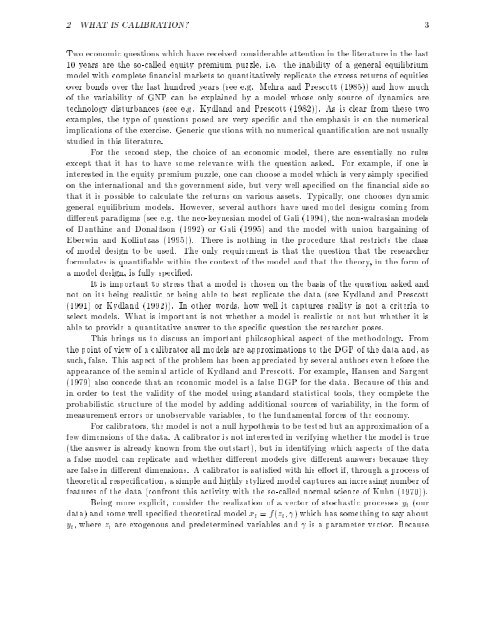Testing Calibrated General Equilibrium Models - Universitat ...
Testing Calibrated General Equilibrium Models - Universitat ...
Testing Calibrated General Equilibrium Models - Universitat ...
Create successful ePaper yourself
Turn your PDF publications into a flip-book with our unique Google optimized e-Paper software.
2 WHAT IS CALIBRATION? 3<br />
Two economic questions which have received considerable attention in the literature in the last<br />
10 years are the so-called equity premium puzzle, i.e. the inability of a general equilibrium<br />
model with complete nancial markets to quantitatively replicate the excess returns of equities<br />
over bonds over the last hundred years (see e.g. Mehra and Prescott (1985)) and how much<br />
of the variability of GNP can be explained by a model whose only source of dynamics are<br />
technology disturbances (see e.g. Kydland and Prescott (1982)). As is clear from these two<br />
examples, the type of questions posed are very speci c and the emphasis is on the numerical<br />
implications of the exercise. Generic questions with no numerical quanti cation are not usually<br />
studied in this literature.<br />
For the second step, the choice of an economic model, there are essentially no rules<br />
except that it has to have some relevance with the question asked. For example, if one is<br />
interested in the equity premium puzzle, one can choose a model which isvery simply speci ed<br />
on the international and the government side, but very well speci ed on the nancial side so<br />
that it is possible to calculate the returns on various assets. Typically, one chooses dynamic<br />
general equilibrium models. However, several authors have used model designs coming from<br />
di erent paradigms (see e.g. the neo-keynesian model of Gali (1994), the non-walrasian models<br />
of Danthine and Donaldson (1992) or Gali (1995) and the model with union bargaining of<br />
Eberwin and Kollintzas (1995)). There is nothing in the procedure that restricts the class<br />
of model design to be used. The only requirement is that the question that the researcher<br />
formulates is quanti able within the context of the model and that the theory, in the form of<br />
a model design, is fully speci ed.<br />
It is important to stress that a model is chosen on the basis of the question asked and<br />
not on its being realistic or being able to best replicate the data (see Kydland and Prescott<br />
(1991) or Kydland (1992)). In other words, how well it captures reality is not a criteria to<br />
select models. What is important is not whether a model is realistic or not but whether it is<br />
able to provide a quantitative answer to the speci c question the researcher poses.<br />
This brings us to discuss an important philosophical aspect of the methodology. From<br />
the point of view of a calibrator all models are approximations to the DGP of the data and, as<br />
such, false. This aspect of the problem has been appreciated by several authors even before the<br />
appearance of the seminal article of Kydland and Prescott. For example, Hansen and Sargent<br />
(1979) also concede that an economic model is a false DGP for the data. Because of this and<br />
in order to test the validity of the model using standard statistical tools, they complete the<br />
probabilistic structure of the model by adding additional sources of variability, in the form of<br />
measurement errors or unobservable variables, to the fundamental forces of the economy.<br />
For calibrators, the model is not a null hypothesis to be tested but an approximation of a<br />
few dimensions of the data. A calibrator is not interested in verifying whether the model is true<br />
(the answer is already known from the outstart), but in identifying which aspects of the data<br />
a false model can replicate and whether di erent modelsgive di erent answers because they<br />
are false in di erent dimensions. A calibrator is satis ed with his e ort if, through a process of<br />
theoretical respeci cation, a simple and highly stylized model captures an increasing number of<br />
features of the data (confront this activity with the so-called normal science of Kuhn (1970)).<br />
Being more explicit, consider the realization of a vector of stochastic processes yt (our<br />
data) and some well speci ed theoretical model xt = f(zt ) which has something to say about<br />
yt, where zt are exogenous and predetermined variables and is a parameter vector. Because
















